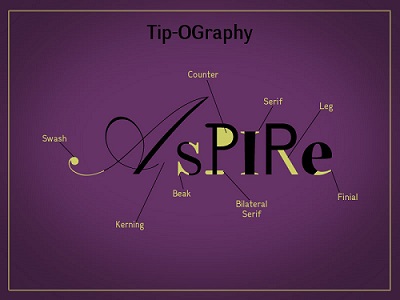After understanding the profound influence of typography in an earlier article, every designer would feel the necessity to dwell more into type. To start with, as Graphic Designers, you would have to know the basic terms involved in a type.
With the help of the below illustration let's discuss few important terminologies in ‘Type’.

SWASH
Swash is the decorative extension from a stem. This is basically an exaggerated serif. These types of fonts were used more in the 16th Centuries and relate to a more vintage handwriting.
Another interesting thing about it is: Swash is usually seen in Italic fonts.
LEG
The leg is the sloping stroke, as in letters 'K' and 'R'. These terms may come into play while designing a logo or movie/book titles.
KERNING
KERNING is the spacing between two consecutive characters. As it is in the above image, the space between ‘A’ and ‘S’. Now, this can be increased in spacing out your word to align with other words in a visually appealing manner.
Now that you have a fair idea of what Kerning is, you need to know ‘Tracking’ and ‘Leading’.
Tracking is the overall spacing between the characters in a sentence.

Whereas, Leading is the space between two lines.
SERIF
Serif is the slight extension from the stem. Serifs originated in the Latin alphabet with inscriptional lettering—words carved into stone in Roman antiquity.
-Wikipedia
Serif is usually preferred for writing the body content, be it newspaper, magazines or brochures, because it is easier to read.
San-serif is the one without the extension.
BEAK
A Beak is a more prominent extension — more like a Serif. It is distinctively sharp and is found on the top part of the letter.
BILATERAL SERIF
Bilateral Serif is the extension from both sides of a stem. You can look at the above image for the letter ‘P’ to know what it exactly means.
FINIAL
A Finial is a tapered end in lower case fonts, such as letter ‘e’ or ‘c’.
COUNTER
A Counter is a round space or empty space found in letters like 'P', ‘Q’, ‘R’ and 'O'.
Now that you are familiar with these terminologies, next time you may refer to them in a much professional way.